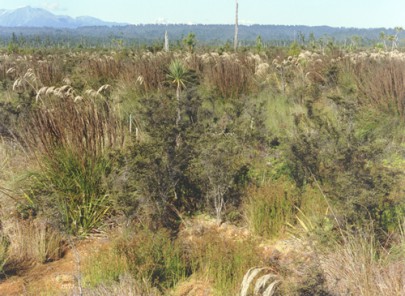Pakihi
In this section

Pakihi, Westland (Rowan Buxton)
Pakihi are a type of wet heath, characterised by very infertile soils with an impervious horizon and little or no peat. In South Westland, pakihi have developed as a result of natural processes of inundation of soils where there is impeded drainage combined with soils becoming very infertile as a consequence of developing in areas of very high rainfall. These soils are too infertile to support closed forest. Pakihi-type vegetation, as occurs in northern Westland, has been induced by human fire. Pakihi share both environmental and vegetation features with North Island gumlands. Characteristic species are manuka (Leptospermum scoparium), wire rush (Empodisma minus), Centrolepis pallida and tangle fern (Gleichenia dicarpa).
Notable flora and fauna
There are no threatened plants in pakihi but the orchid Calochilus paludosusis naturally uncommon. Threatened and rare fauna include the fernbird (Bowdleria punctata punctata).
Threat status
Not threatened (Holdaway et al. 2012)
Threats
Weed invasion primarily occurs on the margins, e.g. gorse (Ulex europaeusi), pasture weeds and grasses, and there may be some damage on the margins in agricultural settings. Pakihi may be threatened by peat mining and by coal mining when they occur over coal measures. They are subject to burning, especially in dry seasons when there has been a build up of fuel. They have often been burned by hunters, who are probably the most frequent human visitors.
Where do they occur?
Pakihi are confined to the west of the South Island where they are widely scattered, particularly on old outwash gravels.
Further reading
Agnew ADQ, Rapson GL, Sykes MT, Wilson JB 1993. The function ecology of Empodisma minus (Hook. f.) Johnson & Cutler in New Zealand ombrotrophic mires. New Phytologist 124:703-710.
Anon 1985. Vascular plants of Haast-Arawata District. Botany Division DSIR Unpublished report 535a.
Duncan RP, Norton DA, Woolmore CB 1990. The lowland vegetation pattern, south Westland, New Zealand 2. Ohinemaka Forest. New Zealand Journal of Botany 28: 131-140. [contains map]
Johnson P, Gerbeaux P 2004. Wetland types in New Zealand. Wellington, Department of Conservation.
Mark AF, Smith PMF 1975. A lowland vegetation sequence in south Westland: pakihi bog to mixed beech-podocarp forest. Part 1: The principal strata. Proceedings of the New Zealand Ecological Society 22: 76-92.
Mew G 1983. Application of the term "pakihi" in New Zealand - A review. Journal of the Royal Society of New Zealand 13: 175-198.
Norton DA 1989. Floristics and structure of mire-forest ecotones, West Coast, South Island, New Zealand. Journal of the Royal Society of New Zealand 19: 31-42.
Norton DA, Leathwick JR 1990. The lowland vegetation pattern, south Westland, New Zealand 1. Saltwater Ecological Area. New Zealand Journal of Botany 28: 41-51.
Rigg HH 1962. The pakihi bogs of Westport, New Zealand. Transactions of the Royal Society of New Zealand 7: 92-108.
Robertson AW, Mark AF, Wilson JB 1991. Ecology of a coastal lagoon to dune forest sequence, south Westland, New Zealand. New Zealand Journal of Botany 29: 17-30.
Scott GAM, Rowley JA 1975. A lowland vegetation sequence in south Westland: pakihi bog to mixed beech-podocarp forest. Part 2: Ground and epiphytic vegetation. Proceedings of the New Zealand Ecological Society 22: 93-108.
Wardle P 1977. Plant communities of Westland National Park (New Zealand) and neighbouring lowland and coastal areas. New Zealand Journal of Botany 15: 323-398.
Wardle P 1980. Primary succession in Westland National Park and its vicinity, New Zealand. New Zealand Journal of Botany 18: 221-232.
Wardle P 1991. Vegetation of New Zealand. Cambridge University Press. 672 p.
Williams PA, Courtney C, Glenny D, Hall G, Mew G 1990. Pakihi and surrounding vegetation in North Westland. Journal of the Royal Society of New Zealand 20: 179-203.


